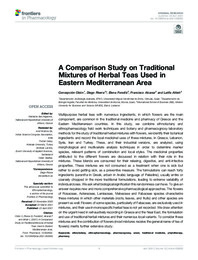Resumen :
Multipurpose herbal teas with numerous ingredients, in which flowers are the main
component, are common in the traditional medicine and pharmacy of Greece and the
Eastern Mediterranean countries. In this study, we combine ethnobotany and
ethnopharmacology field work techniques and botany and pharmacognosy laboratory
methods for the study of traditional herbal mixtures with flowers, we identify their botanical
ingredients and record the local medicinal uses of these mixtures, in Greece, Lebanon,
Syria, Iran and Turkey. These, and their industrial versions, are analyzed, using
morphological and multivariate analysis techniques in order to determine marker
species, relevant patterns of combination and local styles. The medicinal properties
attributed to the different flowers are discussed in relation with their role in the
mixtures. These blends are consumed for their relaxing, digestive, and anti-infective
properties. These mixtures are not consumed as a treatment when one is sick but
rather to avoid getting sick, as a preventive measure. The formulations can reach forty
ingredients (sarantha in Greek, arbain in Arabic language of Palestine), usually entire or
coarsely chopped in the more traditional formulations, leading to extreme variability of
individual doses. We ask what biological signification this randomness can have. To give an
answer requires new and more comprehensive pharmacological approaches. The flowers
of Rosaceae, Asteraceae, Lamiaceae, Malvaceae and Fabaceae species characterize
these mixtures in which other materials (roots, leaves, and fruits) and other species are
present as well. Flowers of some species, particularly of Fabaceae, are exclusively used in
mixtures, and their use in monospecific herbal teas is not yet recorded. We draw attention
on the urgent need in exhaustively recording in Greece and the Near East, the formulation
and use of traditional herbal mixtures and their numerous local variants. To consider these
mixtures and the contribution of flowers (most mixtures receive the general name of tea of
flowers) merits further extensive study.
|
 La licencia se describe como: Atribución-NonComercial-NoDerivada 4.0 Internacional.
La licencia se describe como: Atribución-NonComercial-NoDerivada 4.0 Internacional.
.png)
